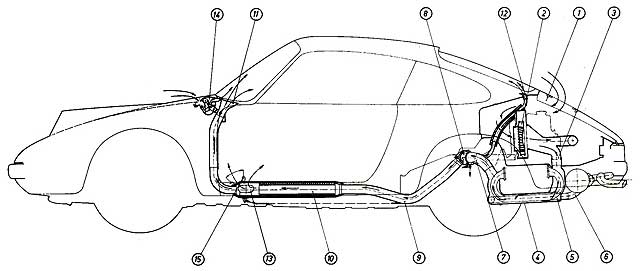



Description of the 356B/T6 Heating SystemFunctional View of the Heating System (Germany and Sweden)Due to varying laws in force, it is necessary to equip The Type 912 cars with two different heating systems. Cars manufactured for sale in Germany and Sweden are equipped with a modified heating system known as 356 B/T6 whereas all other Type 912 export cars continue to be equipped with the well-proven and reliable Export-type heating system. The difference between the two systems is that in the 356 B/T6 system the air required for heating is drawn from the air blower housing and ducted to the passenger compartment through the heat exchangers, without passing through the engine cooling cycle. In the Export-type heating system the cold air performs its engine cooling function and, already preheated, is ducted into the heat exchanger and on to the passenger compartment. The desired effectiveness of both heaters is achieved through the use of appropriately designed heat exchangers.  Functional Description:The entire fresh air mass enters through slots in the engine compartment lid (1), being drawn in by the cooling air blower. Part of the fresh . air mass required for heating the passenger compartment is diverted from the cooling air blower (2) into a separate duct (3), The fresh air (outside air) flows from the supply duct through the two heat exchangers (4) at the engine. The heat exchangers consist of sheet- metal jackets which enclose the exhaust pipes (5). All detachable and welded joints of the exhaust system (6) are located outside the heat exchangers. The entire engine exhaust system as well as most part of the engine, such as the crankcase and cylinders, is located in the free-air stream beneath the rear section of the car. The heating air flows from both heat exchangers' through connecting hoses (7), air gates (8), guide ducts (9), and silencers (10) which are situated within the longitudinal chassis support members, to heat outlets arranged in pairs. Heat outlets are provided as follows:For defrosting the windshield (11) and the rear window (12) by way of defroster nozzles. For the forward leg area (pedal area) by way of sliding gates (13) located alongside the longitudinal chassis supports next to both seats. The air gates (8) are so designed as to permit a continuous flow of air through the heat exchangers (over the exhaust pipes) regardless whether the heat is turned on or off. In addition, outside air may be let in through the ventilating system (14) in front of the windshield independently of the cars heating system. Hot air for preheating the carburetors is taken from the hot air stream. Operating description:Links
Site Details.
Disclaimer.
Comments? Questions?
Dave Hillman
Content attribted to others remains their property. Otherwise the text and images are licensed under a Creative Commons License. 

|